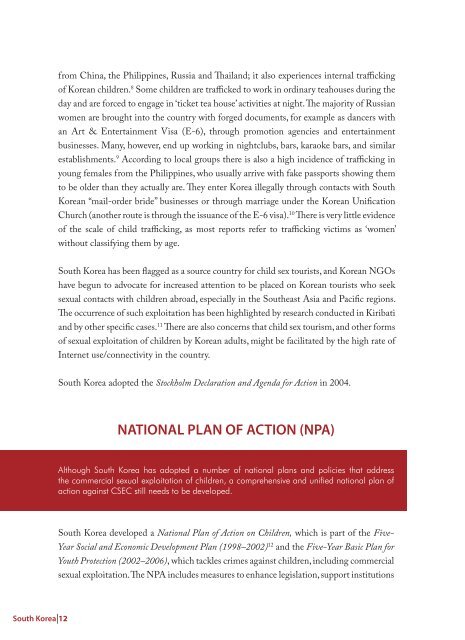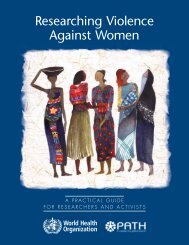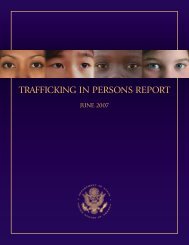South Korea - ECPAT International
South Korea - ECPAT International
South Korea - ECPAT International
You also want an ePaper? Increase the reach of your titles
YUMPU automatically turns print PDFs into web optimized ePapers that Google loves.
from China, the Philippines, Russia and Thailand; it also experiences internal trafficking<br />
of <strong>Korea</strong>n children. 8 Some children are trafficked to work in ordinary teahouses during the<br />
day and are forced to engage in ‘ticket tea house’ activities at night. The majority of Russian<br />
women are brought into the country with forged documents, for example as dancers with<br />
an Art & Entertainment Visa (E-6), through promotion agencies and entertainment<br />
businesses. Many, however, end up working in nightclubs, bars, karaoke bars, and similar<br />
establishments. 9 According to local groups there is also a high incidence of trafficking in<br />
young females from the Philippines, who usually arrive with fake passports showing them<br />
to be older than they actually are. They enter <strong>Korea</strong> illegally through contacts with <strong>South</strong><br />
<strong>Korea</strong>n “mail-order bride” businesses or through marriage under the <strong>Korea</strong>n Unification<br />
Church (another route is through the issuance of the E-6 visa). 10 There is very little evidence<br />
of the scale of child trafficking, as most reports refer to trafficking victims as ‘women’<br />
without classifying them by age.<br />
<strong>South</strong> <strong>Korea</strong> has been flagged as a source country for child sex tourists, and <strong>Korea</strong>n NGOs<br />
have begun to advocate for increased attention to be placed on <strong>Korea</strong>n tourists who seek<br />
sexual contacts with children abroad, especially in the <strong>South</strong>east Asia and Pacific regions.<br />
The occurrence of such exploitation has been highlighted by research conducted in Kiribati<br />
and by other specific cases. 11 There are also concerns that child sex tourism, and other forms<br />
of sexual exploitation of children by <strong>Korea</strong>n adults, might be facilitated by the high rate of<br />
Internet use/connectivity in the country.<br />
<strong>South</strong> <strong>Korea</strong> adopted the Stockholm Declaration and Agenda for Action in 2004.<br />
NATIONAL PLAN OF ACTION (NPA)<br />
Although <strong>South</strong> <strong>Korea</strong> has adopted a number of national plans and policies that address<br />
the commercial sexual exploitation of children, a comprehensive and unified national plan of<br />
action against CSEC still needs to be developed.<br />
<strong>South</strong> <strong>Korea</strong> developed a National Plan of Action on Children, which is part of the Five-<br />
Year Social and Economic Development Plan (1998–2002) 12 and the Five-Year Basic Plan for<br />
Youth Protection (2002–2006), which tackles crimes against children, including commercial<br />
sexual exploitation. The NPA includes measures to enhance legislation, support institutions<br />
<strong>South</strong> <strong>Korea</strong>|12
















